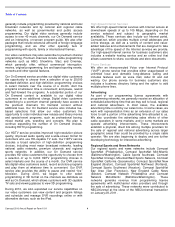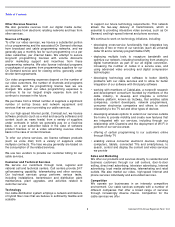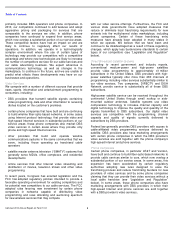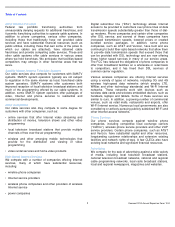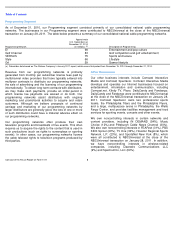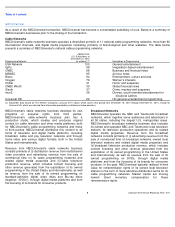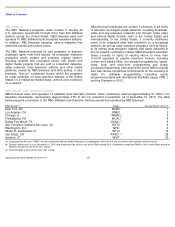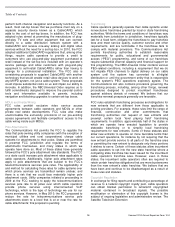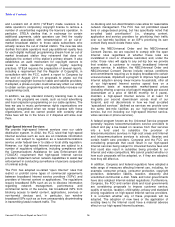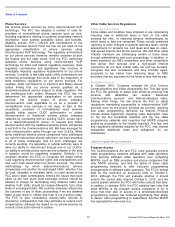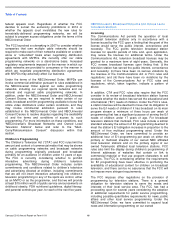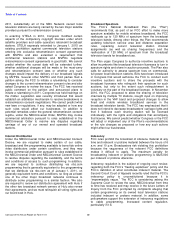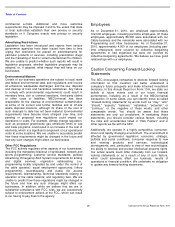Comcast 2010 Annual Report Download - page 18
Download and view the complete annual report
Please find page 18 of the 2010 Comcast annual report below. You can navigate through the pages in the report by either clicking on the pages listed below, or by using the keyword search tool below to find specific information within the annual report.
Table of Contents
Comcast 2010 Annual Report on Form 10-K
14
appellate court in 2001, though the FCC continues to enforce
it. The FCC previously clarified that, under the 40% limit,
cable systems with 75 or more channels must carry at least
45 unaffiliated channels. Our cable systems routinely carry
more than 45 unaffiliated channels, and, as of the date of this
Annual Report on Form 10
-K, comply with the 40% limit.
Compliance could become more difficult depending on what
rules, if any, the FCC adopts.
Pricing and Packaging
The Communications Act and FCC regulations limit the
prices that cable operators may charge for basic video
service, equipment and installation. These rules do not apply
to cable systems that the FCC determines are subject to
effective competition, or where franchising authorities have
chosen not to regulate rates. As a result, 74% of our video
customers are not subject to rate regulation, and, as of
December 31, 2010, we have pending before the FCC
additional petitions for determination of effective competition
for systems covering another 4% of our video customers.
From time to time, Congress and the FCC consider imposing
new pricing or packaging regulations, including proposals
that would require cable operators to offer programming
networks on an a la carte or themed-tier basis instead of, or
in addition to, our current packaged offerings. As discussed
under “Legal Proceedings,” we and others are currently
involved in litigation that could force us and other MVPDs to
offer programming networks on an a la carte basis.
Additionally, uniform pricing requirements under the
Communications Act may affect our ability to respond to
increased competition through offers that aim to retain
existing customers or regain those we have lost.
Program Carriage/License Agreements
The Communications Act and FCC rules prohibit cable
operators and other MVPDs from requiring a financial interest
in, or exclusive distribution rights for, any video programming
network as a condition of carriage, or from unreasonably
restraining the ability of an unaffiliated programming network
to compete fairly by discriminating against the network on the
basis of its non-affiliation in the selection, terms or conditions
for carriage. The FCC is considering proposals to expand its
program carriage regulations. The adoption of these
proposals could have an adverse effect on our businesses.
The NBCUniversal Order also prohibits discriminating against
a network on the basis of its non-affiliation in the selection,
terms or conditions for carriage, under a standard that is
comparable to existing law, and requires that, if we carry
news and/or business news channels in a channel lineup
“neighborhood” (defined as placing a significant number or
percentage of news and/or business news channels
substantially adjacent to one another in a system channel
lineup), we must carry all independent news and business
news channels in that neighborhood. We have been, and
currently are, involved in program carriage disputes at the
FCC and may continue to be subject to program carriage
complaints in the future. Adverse decisions in any such
disputes could negatively affect our business. In addition, the
NBCUniversal
Order requires us, on a specified schedule over the next
eight years, to add ten new independently owned and
operated channels to the digital tier of our cable systems.
Must-Carry/Retransmission Consent
Cable operators are currently required to carry, without
compensation, the programming transmitted by most local
commercial and noncommercial television stations.
Alternatively, local television stations may choose to
negotiate with a cable operator for retransmission consent,
under which the station gives up its must-carry right and
instead seeks to negotiate a carriage agreement with the
cable operator. Such an agreement may involve payment of
compensation to the station. We expect to be subject to
increasing demands, including demands for direct monetary
compensation and other concessions, by local television
stations in exchange for their required consent for the
retransmission of broadcast programming to our video
services customers.
Now that broadcasters have completed their transition from
analog to digital transmission, cable operators generally are
required to carry the primary digital programming stream of
local broadcast stations, as well as an analog version of the
primary digital programming stream on systems that are not
all digital. These requirements are scheduled to last until
June 12, 2012, subject to possible extensions. For more
information on must-carry and retransmission consent issues
relating to NBCUniversal’s broadcast businesses, see
“NBCUniversal’s Broadcast Networks and Owned Local
Television Stations” below and refer to the “Must-
Carry/Retransmission Consent” discussion within that
section.
Leased Access
The Communications Act requires a cable system to make
available up to 15% of its channel capacity for commercial
leased access by third parties to provide programming that
may compete with services offered directly by the cable
operator. While we have not been required to devote
significant channel capacity to leased access to date, the
FCC has adopted rules that dramatically reduce the rates we
can charge for leased access channels, although their
implementation has been stayed by a federal court pending
the outcome of a challenge brought by us and other cable
operators and also has been blocked by the Office of
Management and Budget. If implemented, these rules could
adversely affect our business by significantly increasing the
number of cable system channels occupied by leased access
users and by significantly increasing the administrative
burdens and costs associated with complying with such rules.
Cable Equipment
The FCC has adopted regulations aimed at promoting the
retail sale of set-top boxes and other equipment that can be
used to receive digital video services. With the exception of
certain one-way devices, like the digital transport adapters
we have been deploying as part of our all digital conversion,
these regulations prohibit cable operators from deploying
new set-top boxes that


